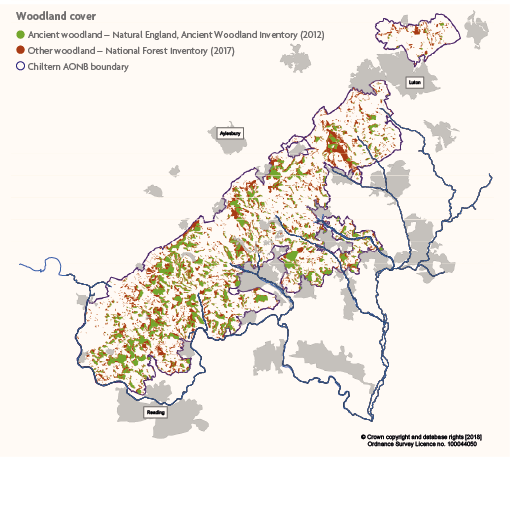environmental SCIENTIST | Right Tree • Right Place | March 2019
John Morris explores the environmental archaeology and current challenges of these important ecosystems.
The Chiltern Hills stretch across four counties, from Goring in Oxfordshire, across Buckinghamshire and Bedfordshire to Hitchin in Hertfordshire, with the River Thames on their southern edge. This iconic landscape, designated as an area of outstanding natural beauty (AONB), is well known for its beech (Fagus sylvatica) woodlands with carpets of bluebells (Hyacinthoides non-scripta), rare orchids, prehistoric trails and wooded commons. The Chiltern Hills are one of the most heavily wooded areas in England, with over 22 per cent woodland cover, of which nearly 60 per cent is ancient woodland1 (see Box 1). Which tree grows where depends on a combination of natural environmental and cultural factors, with the soil type and moisture levels being important, along with management history and the source of seeds. Most of the ancient woodlands here are now found on the clay with flint soils that cap the Cretaceous chalk hilltops. Much of the plateau is overlain by Tertiary clays and sand deposits, which result in acidic habitats and the formation of oak–beech woodlands on heavier soils.
A characteristic indicator feature of lowland ancient woodlands is the presence of a wood bank, which consists of an earth bank, with an associated ditch, constructed at the boundary of a woodland or bordering internal compartments. These banks were used to keep out both grazing animals and human intruders as well as to demarcate ownership. In many cases they would have been topped by a hedge or a fence. Sometimes in the Chilterns the ditch is on the woodland side of the bank, but woods bordering commons usually have a wide ditch on the commons side.2
The boundaries of intact older woods are rarely straight and often follow natural features and topography. Surviving fragments of historically larger woods may have straight margins where boundaries were moved by clearance for agriculture, a process known as assarting. This was common from the medieval period onwards, and evidence of it can be seen around the edges and within larger woods.
Woodlands in use
The River Thames was historically an important waterway supplying London with raw materials, including wood for fuel, building and other uses. Towns such as Henley on Thames and Marlow developed as riverside ports and wood including beech, oak and hornbeam was delivered to London in barges. Chiltern woods were an important resource throughout the medieval period and their former economic importance is why they have survived to the present day.
Woodland clearance for agriculture, in the Chilterns as well as elsewhere, declined in the 13th century following the Black Death. In 1610, William Camden described the area as ‘beset with thicke woods’3 and in 1768 Arthur Young described the ‘perpetual woods of beech’.4 But the fuel provided by woodlands was in high demand. This led to the active management and maintenance of existing woodland stocks. Beech woods in the past did not look like the ones we see today, as the young trees were repeatedly cut down (coppiced or selectively thinned) for poles or fuel and allowed to regrow (given enough light and protection from animals). This was a sustainable method of managing broadleaved woodland species such as ash (Fraxinus excelsior), field maple (Acer campestre), hazel (Corylus avellana), hornbeam (Carpinus betulus) and sweet chestnut (Castanea sativa). In a few places in the Chilterns, such as Low Scrubs, there is still old beech coppice, which may be hundreds of years old.
By the end of the 18th century, the demand for wood declined because it was replaced by coal as the preferred fuel in London. Many woods in the Chilterns were left to grow into stands of tall beech trees. This then became the resource for bodgers (those who turned chair parts on pole lathes), with chairmaking and other woodworking industries centred on High Wycombe and Chesham. By 1877, there were almost 100 factories in High Wycombe making 4,700 chairs a day,5 and by 1911 2 million chairs were being made annually.
|
Box 1: Woodland definitions |
|
The wildwood was more complex and dynamic than today's woods, with areas of open wetland, marsh and clearings maintained by flooding, windblow and large herbivores. The landscape became more fixed during the medieval period with farmland, woodland and commons all more clearly defined as land uses and under various types of land ownership marked by boundary banks and hedges. Today fragments of woodland remain as 'ecological islands' in a largely agricultural landscape. Ancient woodland is a nationally important and threatened habitat; its existence over hundreds of years has preserved irreplaceable ecological and historical features. It was originally defined for botanical habitat reasons but has now been extended to recognise their importance as part of the historic environment and cultural heritage, and therefore for planning. The government's Keepers of Time policy8 aims to protect ancient woodland. Ancient woodland in England is defined as an area that has been wooded continuously since or before 1600 CE. The date used to define ancient woodland for England was chosen by George Peterken because it reflected the point at which maps started to become more common and was prior to the impetus for new woodland planting from the publication of John Evelyn’s influential book Sylva (1664). Ancient woodland has two sub-categories: ancient semi-natural woodland and plantations on ancient woodland sites. The trees and shrubs found in ancient semi-natural woods may have been felled or cut for coppice at various times since 1600, but provided it has remained as woodland, i.e. the coppice stools have regrown or the stand has regenerated or been replanted soon after felling, then it counts as ancient woodland. Trees may have been cut many times in the past, so ancient woods do not necessarily contain large old trees. Plantations on ancient woodland sites (PAWS) are areas where the original native tree cover has been replaced by planted stock, for example conifers such as Norway spruce (Picea abies), Douglas fir (Pseudotsuga menziesii) or Corsican pine (Pinus nigra var. maritima), but also broadleaves such as sycamore (Acer pseudoplatanus) or sweet chestnut (Castanea sativa). Secondary or recent woodland (less than 400 years old) has either been planted or allowed to grow naturally, often on former agricultural land. |
Woodland archaeology
Woods are an important part of the historic landscape, with many cultural associations. The archaeological evidence that survives under the trees in the form of lumps and bumps, pits and banks, can be interpreted to explain the history of land use, although some features have been damaged by machinery or changes of use. Many historic features have been found in woods, and there is still much to identify, survey and record:
- Living evidence relating to the past management of a wood, for example, coppice structure, aged coppice stools, veteran trees or pollards;
- Archaeological evidence relating to the past management of the site such as saw pits, charcoal hearths, drainage systems, old banks, tracks, mineral diggings;
- Physical features indicating a previous agricultural land use, such as ridge-and-furrow plough markings and lynchets (ploughed terraces); and
- Historical boundary features, such as wood banks, stubbed trees and outgrown laid hedges.
Some of the earliest evidence of woodland management is the discovery of iron slag from smelting in the Iron Age and Roman period. The iron workers would have used charcoal made in the woodland itself. Smelting and charcoal-making sites have been discovered in several woods in the Chilterns.
A later example is the existence of saw pits, which are frequent in ancient woods in the Chilterns because the woods were high forest (ie the trees were tall) rather than coppice, and the ground conditions were suitable for pit construction. Most sawpits in the woods are a little over 4 m long (dug along the contour) by a couple of metres wide. There is a mound on the lower edge. A wooden frame supported the log to be cut. Some were backfilled after use, so the depth is variable. As everyone locally knew what they were, the information was rarely written down – so it took a visitor from Finland to record their use in detail. Pehr Kalm stayed at Little Gaddesden, on the Hertfordshire–Buckinghamshire border, in 1748. In his diaries he described the use of saw pits:6
“When the tree is felled, they do not go to the expense of taking the whole tree away but saw it into pieces where it grew, digging a pit, where the tree can be sawn into boards or whatever is needed. While in Sweden we have sawyers’ trestles, onto which logs must be lifted with considerable difficulty before they are sawn. Here, it is the practice to dig a saw pit. One man stands down in the pit and the other above it, each holding his end of the saw. If they wish to saw across them the logs are rolled across the pit, if they wish to saw them into boards, they are placed lengthways along the pit. In this way, the need to hoist the logs onto a sawing bench or higher structure is avoided.”
New survey techniques include lidar (an aerial technique using lasers), which can reveal the landform beneath the trees. The Chilterns AONB is being flown to produce a high-resolution lidar survey as part of a Heritage Lottery Funded Hillforts Project.7 There are more than 20 hillforts across the Chilterns, most date from the Iron Age and these must have been created in a less-wooded landscape.
 |
| Distribution of woodland cover in the Chiltern Area of Natural Beauty. |
Current problems
Current threats to trees in Chilterns include diseases and pests, climate change and changing management practices.
Sadly the health of trees across the Chilterns continues to deteriorate. Ash dieback (Hymenoscyphus fraxineus) is now found widely. All ages of ash are starting to suffer from this fungal disease, although it is most noticeable on ash saplings in the summer. It is likely to kill millions of ash trees across England, with those along roads and in hedges being harder to replace. Some mature (but not old) oaks are affected by acute oak decline. Pines (Pinus spp.), horse chestnuts (Aesculus hippocastaneum) and elms (Ulmus spp.) also have disease problems. There is also the potential for some serious insect pests to harm woods in the future, such as oak processionary moth (Thaumetopoea processionea), currently not far away in west London.
The cumulative impact of bark stripping year after year on younger ‘pole stage’ trees by grey squirrels (Sciurus carolinensis) on beech, oak (Quercus spp.), birch (Betula spp.) and many others, means it is now difficult to establish the next generation of trees. Increasing numbers of fallow (Dama dama), muntjac (Muntiacus reevesi) and roe deer (Capreolus capreolus) are browsing down natural regeneration and planted trees and damaging the ground flora. Controlling squirrel and deer numbers is particularly difficult in smaller woods and with multiple woodland owners.
One particular Chilterns problem species is the edible dormouse (also called the fat dormouse; Glis glis). This nocturnal mammal was introduced from Europe at Tring in 1902. They are now present across much of the Chilterns AONB and can cause serious problems. They damage the tops of trees, including wild cherry (Prunus avium) and many species of commercial conifer, adding to the problems caused by bark-stripping grey squirrels. Edible dormice predate woodland birds on their nests, eating adults, eggs or nestlings. There is a real risk that this species will spread from the Chilterns to other parts of England. One potential means of spread is in firewood: edible dormice may hide in log stacks while they are active over the summer months. Firewood is often left to dry in the wood in stacks through the summer for sale in autumn when demand and price is higher. When lorries collect these logs the edible dormice might be moved to new areas.
These tree health problems and a changing climate, with more droughts and storms, mean it is becoming increasingly difficult to know what tree species to grow. The warming climate may lead to some species of tree struggling to survive, particularly if summers become hotter and drier; the prediction is that beech may struggle on some soils. Alternatives might include small-leaved lime (Tilia cordata), English (pedunculate) oak (Quercus robur) and perhaps tree species introduced from other countries. The woods are likely to become more varied in composition, with more light coming through the canopy, which will influence the ground vegetation. It is a real concern that we may be the last generation to walk through a fine stand of native hardwoods.
The woods of the Chilterns survived because they were a valuable resource. Veteran trees, ancient coppice and old hedges are all important features of the historic landscape and should be retained where possible.
John Morris BSc CBiol MRSB is the Director of the Chiltern Woodlands Project, a registered charity based in the Chilterns AONB office. The Chiltern Woodlands Project offers advice and assistance with woodland management to owners of woods in the Chilterns. It was founded in 1988. John has been working for the project since the start and works with volunteer groups and contractors to implement plans. woodlands@chilternsaonb.org @ChilternWoods
1. Chilterns Conservation Board. Ancient Woodland. https://www.chilternsaonb.org/about-chilterns/woodlands/ancient-woodland.html (accessed 7th February 2019).
2. Morris, J.K. (2010) The Cultural Heritage of Chiltern Woods: An illustrated guide to archaeological features. Chiltern Woodlands Project. Available at https://www.chilternsaonb.org/Products/3/The-Cultural-Heritage-of-Chiltern-Woods.html
3. Camden, W. (1610) Britain, or, a Chorographical Description of the most flourishing Kingdomes, England, Scotland, and Ireland. London: George Bishop and John Norton.
4. Young, A. (1784) Tours in England and Wales: Selected from the Annals of Agriculture. London: the London School of Economics and Political Science.
5. Mayes, L. J. (960) The History of Chair Making in High Wycombe. London: Routledge & Kegan Paul.
6. Mead, W.R. (2003) Pehr Kalm: A Finnish Visitor to the Chilterns in 1748.
7. Chilterns Area of Outstanding Natural Beauty. Beacons of the Past: Hillforts in the Chilterns Landscape. https://www.chilternsaonb.org/projects/beacons-of-the-past.html (accessed 13th February 2019).
8. Department for Environment, Food and Rural Affairs and Forestry Commission. (2005) Keepers of time: A statement of policy for England's Ancient and Native Woodland. https://www.gov.uk/government/publications/keepers-of-time-a-statement-of-policy-for-englands-ancient-and-native-woodland (accessed 27th February 2019).





